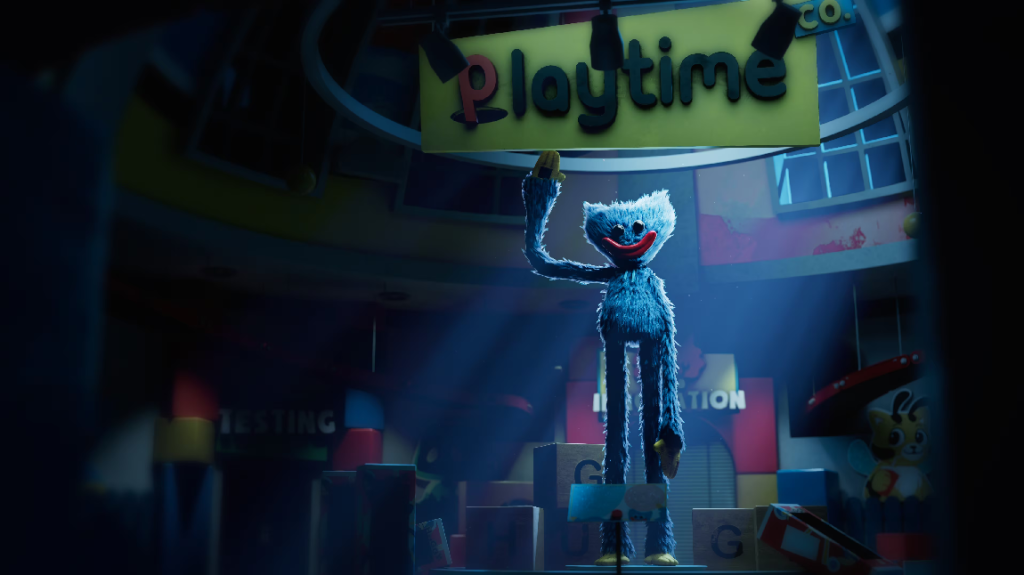
I do not follow trends. I am not a YouTube content creator. If something is ‘the next big thing’ then chances are I am not the absolute last person to hear about it, but I am probably the last person to consciously engage with it. And just to be clear, this isn’t some kind of hipster pride about being indie, I just… genuinely don’t enjoy whatever the main thing happens to be a lot of the time. I’m not generally a fan of shooters, battle royales, and especially mascot horror games. Especially popular mascot horror games with an emphasis on abloogy-woogy-woo jump-scares over atmospheric tension. And especially especially episodic popular mascot horror games with years between each release.
And yet, Poppy Playtime has taken up just enough space in my mind for me to consider it worth taking a deeper look at. And part of why I feel that way is because I have fairly strong feelings that I am conclusively confident in about several facets of the game, but ultimately, if you asked me whether I liked the game or not – or whether I even liked the idea of the game – then… I don’t think I could easily answer that question. I have very mixed feelings about Poppy Playtime. I think they’ve done some things very well, and some things absolutely awfully.
As a quick recap, in case you haven’t visited YouTube at all in the past three years, Poppy Playtime is one of the many big recent mascot horror titles, and while it’s one of the more successful ones, it’s still not even remotely approaching the status of Five Nights at Freddy’s. It’s scrapping with Bendy and the Ink Machine for the chance to be in second place, and Bendy is probably winning by virtue of having multiple finished video games (Mob Entertainment released Chapter One of Poppy Playtime in October 2021, Chapter Two in May 2022, and Chapter Three in January 2024.) However, it’s also not even remotely close to the worst title in its genre; there are so many mascot horror titles that are worse than this in every single regard, lower-quality, lower-effort, and definitely lower exposure.
But just because Poppy Playtime is emphatically not bad, doesn’t mean that I wouldn’t hesitate to call it good. And here are some of the reasons why, starting with the most blatant.
It rips off so many other IPs that I don’t know which one of them should feel the most offended

This image comes from the Huggy Wuggy VS The Rolling Giant rap battle by Freshy Kanal. The accompanying lines are “I supposed we both evoke some sense of nostalgia, cause you remind me of the thousand trends you copied off of.” 4/10 for the rhyme (‘nostalgia’ and ‘off of’) but 10/10 for the burn.
Do you remember the copyright deadlock system, invented by Stephanie Sterling? After receiving so many fraudulent copyright infringement claims on her videos, she started intentionally filling them with footage of Konami games, Nintendo games, and Erasure’s ‘Chains of Love’, on the basis that if multiple companies try to claim the ad revenue for her work, then none of them can actually claim it. A rather fantastic move, with a righteous pettiness surpassed only by her dedication.
Anyway, I, er… I think Poppy Playtime is trying to do that with video games. Can’t get sued for plagiarism if you plagiarise everyone, can you? Real big brain stuff. James Somerton told me that.
Let’s recap the story of Poppy Playtime; a former employee of a big factory involved in the production of children’s entertainment returns to said factory, years later, after it was abandoned following… an incident. They quickly realise that something strange is going on, and are menaced by a former studio mascot turned-
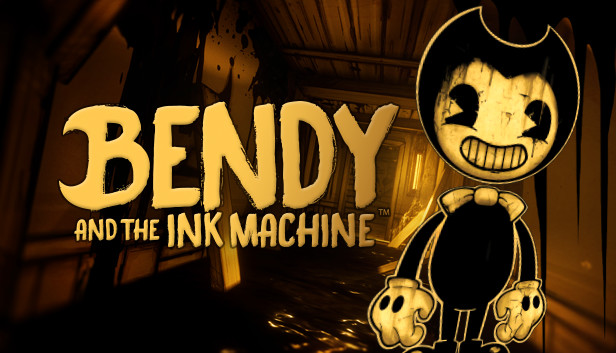
… Ah. Well, alright. I was being a little facetious already there; I said that they were involved in ‘children’s entertainment’ but Bendy is a cartoon and Playtime Co. is a toy manufacturer, although they also used cartoons in advertisements. So to be more accurate, Poppy Playtime is about possessed, demonic or malfunctioning toys, not-

… Ah. Well, alright. The toys themselves aren’t even the main threat anyway, it’s the huge animatronic models of the toys that existed for some reason. They seem to be malfunctioning in a very violent way, and there are vague references to an event from several years ago in which-

… Ah. Well, alright. Also starting in Episode 3, you’re guided by a mysterious child’s voice on a walkie-talkie who claims to be helping you but is very obviously suspicious and-
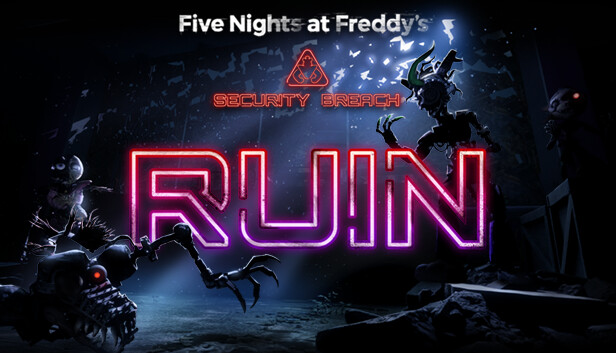
…
Also there are physics puzzles but they’re jank and glitchy as-

Yep, that’s the only reference Hello Neighbor is getting. At least I deemed you worthy of a mention, unlike REDACTED of REDACTED. And this is only referring to other video games; you could make a clear case of being inspired by The Walten Files, or The Mandela Catalogue; hell, you could probably make a half-decent argument that they somehow ripped off Indigo Park, despite coming out two and a half years earlier than it. Why not? They’ve ripped off everything else. Let’s throw Choo-Choo Charles in there as well. Half of the games I’ve mentioned can ultimately be traced back to that Slender fangame anyway.
However, let’s say that for the sake of argument, Poppy Playtime is absolutely 100% the most ripping-off rip-off that has ever ripped off another game. A game that I played earlier this year and loved was Tyrion Cuthbert: Attorney of the Arcane, a game very blatantly inspired by the Ace Attorney series. It’s also slightly lower quality than the Ace Attorney games, albeit not so much to be unenjoyable, and while it starts off as a mere imitation, it gradually forges an identity of its own and I really enjoyed it on its own merits. I don’t want to say too much more because a full Tyrion Cuthbert review is still on the table, along with several other articles I will probably never finish.
But the point is, Tyrion Cuthbert is very openly a… well, not a rip-off, but ‘heavily inspired’ by the Ace Attorney series. And Poppy Playtime is very heavily inspired by Five Nights at Freddy’s and Bendy and the Ink Machine and Tattletail and possibly several other titles. But if it’s acceptable to me when Tyrion Cuthbert does it, it should be acceptable when Poppy Playtime does it too, right? Well, there’s one more very important key distinction between the two.
I like ‘Tyrion Cuthbert: Attorney of the Arcane.’
That’s not an acknowledgement of hypocrisy on my part – or maybe it is and I just haven’t realised it yet – but it’s so much easier to use the term ‘inspired by’ rather than ‘ripping off’ when the final product is actually good. And it’s good because it was able to establish an identity of its own, something which Poppy Playtime has yet to convince me that it has done. I understand that this is something of a self-fulfilling prophecy – Poppy Playtime is a rip-off because it is bad and it’s bad because it’s a rip-off – but I also believe that the more sources you take inspiration from, the fewer original things you actually have to say. Tyrion Cuthbert builds on a base that was established by Ace Attorney, while Poppy Playtime is more akin to wearing the skin of its competitors to try and coast off of some of that uncanny valley ‘possessed/evil animatronic’ crowd that has been around since August 2014.
There is absolutely still time for Poppy Playtime to turn the corner, but the fact that I don’t feel that they’ve established an identity of their own – three chapters into their story – is an indication that there is a very good chance that they will never convince me of that.
The difference in quality between episodes is jarring
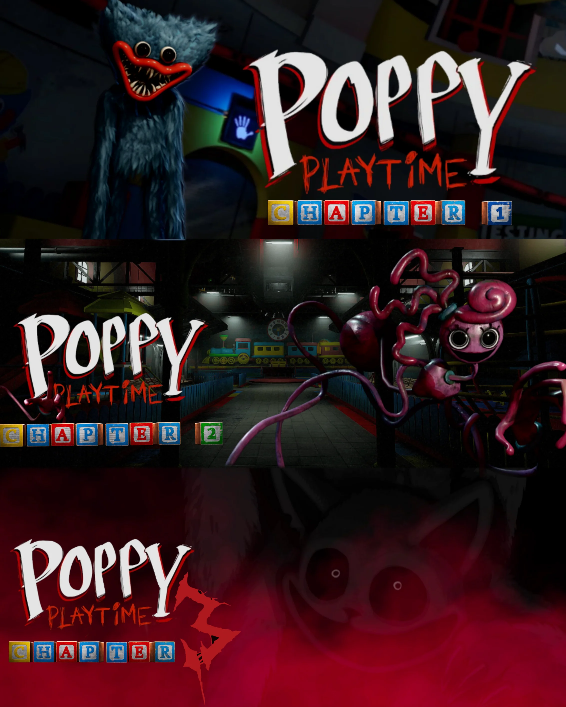
That last point was more negative than mixed, so let’s get to more positive ground; the improvement between Chapter One and Chapter Two of Poppy Playtime was genuinely a very pleasant surprise, and the gulf between quality in Chapter Two and Chapter Three was even more impressive. The first chapter is more or less a proof of concept, with some basic gameplay and then a memorable jump-scare-y chase scene, but not much else. Chapter Two expands the story and gives more background on the characters and the setting, while introducing some new gameplay mechanics, and it all feels much more polished, although it’s still possible to completely break the game with a handful of speedrunning tricks. Chapter Three is… wow. It’s not perfect, but the sheer number of improvements, and how drastic those improvements are, is truly remarkable, and a testament to the talent behind the development team.
Also, I know that quality beats quantity, and it’s not exactly a traditional way to gauge the worth of a game, but let’s head over to Markiplier’s YouTube page and see how long each chapter took him to beat. Chapter One was a solid 33 minutes. Chapter Two is much longer, at 2 hours 44 minutes. Chapter Three had to be split into multiple parts, and ended up at 3 hours and 13 minutes. Chapters Two and Three have, approximately and respectively, five and six times more content than Chapter One. It’s ridiculous how impressive that is.
… And it also completely destroys any hope of a cohesive experience and product. Aha! It was another negative all along.
Alright, I’m not going to seriously stand here and tell you that it’s a bad thing that Poppy Playtime has seen significant improvements from chapter to chapter, and not just because I’m far too lazy to stand for an extended period of time. But it is weird. The works of Telltale Games were fraught with their own flaws, but on a basic level, the length of Episode One of The Walking Dead: Season One is not dissimilar to the length of Episode Five. Even in other episode horror games, such as Bendy and the Ink Machine, then while the episodes gradually become longer, it’s just that; gradual. And it’s not just the difference in length, but the difference in quality. Particularly the quality of the story.
I called Chapter One a proof of concept, and in a demo or sales pitch, that can be a plus. Not so much in an actual finished product. Chapter One is ultimately very unimportant to the overall story and setting of Poppy Playtime in a way that feels unnatural. To compare it to Bendy and the Ink Machine again, the first chapter of that game is also a fairly quick affair, but you are aware of your reason for being there – kind of – you’ve met the main villain, and you’ve already been half-introduced to a number of characters you’ll be bumping into later. It’s not perfect by any means, but do you know when you meet the main villain of Poppy Playtime. At the very end of the chapter. That is, the second chapter. Chapter two. More than three hours into Markiplier’s playthrough (I think we should measure more things in terms of Markiplier,) is the first time you actually get a glimpse of the main villain of the game. That’s… not great.
The first chapter also leaves so much unknown that it’s great for people trying to muscle their way into Game Theory territory and snatch up those sweet ‘Raid: AFK Journey of Tanks’ sponsorship deals, but it’s not great from the point of view of actually telling a story that keeps people engaged. You only encounter one enemy in Chapter One; Huggy Wuggy, an admittedly memorable blue fuzzy smiley thing with sharp metal teeth – all the better to eat you with – but you end the chapter not even knowing if he’s malfunctioning, or possessed, or magic, or evil, or even possibly working as intended. You are breaking in after all.
Much like the multitude of trends Poppy Playtime is chasing, this doesn’t guarantee failure, but it does significantly increase its likelihood, in my opinion. I get the distinct impression that even after Chapter Two was released, the developers were more or less making up the story as they went along. And again; that doesn’t guarantee failure, perhaps they’ll make up a really fantastic story as they go along. But perhaps they won’t. The fact that the first chapter was nothing more than effectively a demo means that the team were wholly aware of the possibility that this wouldn’t gain much traction and plans for the rest of the game would be scrapped. And I don’t really think that results in people bringing their A-game to the table. And even if they prove me wrong – which I sincerely hope that they do; I like it when things are good – then unless they go back and make some kind of remaster or extended cut of Chapter One which better fits the tone and especially the pacing of the rest of the game, then as a collective product, something about Poppy Playtime will always just feel… off to me.
All of the best lore isn’t in the game

Did you know that Poppy Playtime actually has some really cool and interesting lore? That’s nice. It would be nicer if any of it was actually in the sodding game, though.
That’s not exactly fair – and we will get to the positives in the games – but a lot of the most memorable story beats from the world of Poppy Playtime come from teasers, trailers, and analog horror-style videos that can be found uploaded on the developer’s YouTube page. Much like the increasing quality from chapter to chapter, it’s hardly a bad thing that they’re creating engaging content that is present outside of the game… it’s just weird that there’s a significant lack of engaging content in the game to begin with.
Most of this supplementary material can be found on Mob Entertainment’s YouTube channel, and after scrolling past all of the soundtrack uploads and occasional adverts for Huggy Wuggy plushies, you’ll find three videos RESTRICTED_that_are_named_like_this_27-05-2024.mp4. I had to make a tough decision there regarding whether to accurately replicate the names, which have the month before the day in that weird American way. If you’re going to end on the year then it’s clearly ascending order from smallest timeframe to largest, so I don’t know why you would- never mind, I made my decision and I stand by it.
These three videos are nothing exceptional, but they are very well done and they provide much more of a sense of atmosphere than anything in the actual games. The first shows Huggy Wuggy escaping the facility, and there’s something inherently creepier about the black and white, one frame every two seconds security camera footage of a behemoth that should not exist bolting for an exit, than there is about an up close and personal strictly-plotted chase scene. There’s a mandatory jump scare in there, but one of the creepiest parts is the ending, which shows that when Huggy Wuggy was located, he was simply standing motionless, staring into the bedroom window of a particular house, presumably the one that he used to live in.

Also, I’m not sure exactly where to put this, but I still want credit when this obvious truth turns out to be obviously true; the kid on the walkie-talkie who assists you in Chapter Three is named ‘Ollie’, and this video is where we found out that Huggy Wuggy’s code name is Experiment 1170. Or ‘E1170’ for short. Which, if you turn it upside down, spells ‘OLII3’. I’m not MatPat, but I absolutely want to be able to point towards this article and go “See? See?” when this is confirmed. But anyway, despite still having a cheap jump-scare or two – and even that is more effective than normal, because it’s someone actively searching for Huggy Wuggy and finding him, not just him cheaply bursting into view – then it’s a decent video. And it offers a little more explanation in the sense that while these robots or animatronics or magic toys are clearly hostile and have been for a while, they also have goals that are non-violent. All Huggy Wuggy seemingly wanted to do was go home. That’s genuinely sad. And also, several of the staff sent out to look for him were not killed, but ‘went missing’, which… raises questions. My, Huggy Wuggy, what big teeth you have.

The second video is more mysterious and atmospheric, showing the transportation process of… items related to the ‘Bigger Bodies’ program. Starting with Kissy Missy, referred to here as ‘the Giant’. “Retrieve Giant,” “Secure The Giant,” it’s all very vague but business-like. Until the instructions are overlaid with red text giving very different instructions, like “LOOSEN THE STRAPS BINDING THE GIANT,” “RELEASE THE STRAPS BINDING THE GIANT,” “RELEASE THE STRAPS,” etc. Also, while Kissy Missy is loaded onto a train speeding down a tunnel towards… somewhere, then graffiti proclaiming ‘THE HOUR OF JOY IS AT HAND‘ can be seen on the side of the tunnel. The video ends with Kissy released but still motionless on the board she was bound to, surrounded by the bodies of the people transporting her. Nice! Good horror, very enjoyable and suspenseful.
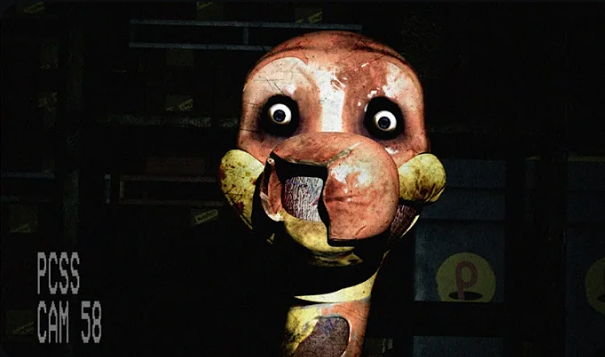
The last video (as of this moment, unless you count some Chapter Three teasers) is arguably the least scary but the most sad, and also the most explicit. You get an actual human actress playing one of the scientists/researchers, explaining that their current ‘subject’ is a former Playtime Co. employee who was diagnosed with terminal lung cancer, and volunteered – of sound mind (allegedly) – for a procedure. Cut to a first-person POV of someone trying to talk to… Bron, a small toy dinosaur, whose eyes are moving in a panicky way. Cut to more exposition and explanation proposing that ‘Experiment 1199’ does not know where he is, and the other experiments could tell that he was ‘different’. Whether this means they could sense his weakness and confusion, or whether they knew that he used to work for Playtime Co., this is unclear, but footage of an attempt to… uh, integrate him with the others is extremely unsuccessful and leads to severe injuries to the small dinosaur. The tape concludes that he is now being kept in isolation for his own safety, and ends on security camera footage of a tiny toy dinosaur, standing motionless and isolated in their own cell. Ouch, my little heart.
As much as I’ve been a negative nelly, these are all great, honestly. I like them a lot, and what’s even more impressive is that they’re all engaging in different ways. Huggy Wuggy’s escape is mostly scares but with a hint of revealing the creature’s motives. The transportation of Kissy Missy shows an active resistance to the company, and a possible hint towards why the factory is so empty when the player finally shows up. And the final video is outright “Yeah, if you didn’t get what we were doing before; weird experiments putting people’s souls into toys, duh,” but with its own small, self-contained story. And all three of them are nice, it’s just a shame that they are significantly more interesting than any of the story beats featured in the actual playable video game experience.
… Until Chapter Three. And the Hour of Joy.
Since I’ve compared Poppy Playtime negatively to Five Nights at Freddy’s a lot so far – and will continue to do so – then I should also give it some credit by pointing out that after almost ten years, ten core games, and several spin-offs… we’ve never actually seen ‘The Bite of 87.’ And to be fair, we don’t need to; it doesn’t actually serve an important narrative purpose in the franchise, it’s just a widely-referenced incident – it’s almost like the FNaF version of ‘Cleganebowl’ from Game of Thrones, something which would be hypothetically cool to see, but ultimately completely meaningless to the story – that the fandom has latched onto. It’s not important for anyone to see, but it’s a bit weird that after all this time, it still remains a mystery.
Poppy Playtime, after teasing us with some vagueness for three chapters, decided to buck this trend by outright saying “Oh, you want to know what happened ten years ago? You want to know the mysterious event that halted the experiments and shut down the factory? Well, we’re going to allude to it a few more times, drop a few more hints, and then in Chapter Five, we’re going to- I’m just kidding, here is the full footage, right now, at the end of Chapter Three.” And it’s… really good, honestly.
It takes the analog horror of the security camera footage of Huggy Wuggy in the first tape, it provides context and clarity for what happened with Kissy Missy in the second tape, and it builds off of the violent and vengeful nature of the experiments demonstrated in the third tape. The Hour of Joy was an hour in which all of the experiments rebelled, killing as many Playtime Co. employees as possible, and while they were extremely justified to seek revenge against a lot of individuals, the wholesale massacre of hundreds of employees is still pretty messed up to see. It’s awe-inspiring in the worst way, which in a horror game is often also the best way.
The music is also fantastic, the generic tune mixed with the static, the track breaking down as the horrors unfold, only to play an ironic distorted children’s TV jingle at the end, gives it all a surreal, otherworldly feel, which I imagine is how you would really feel if you were being hunted by a giant, murderous, spiky blue Q-Tip. I sincerely truly liked this very much, and while I have nothing but well-earned doubts regarding the management at Mob Entertainment and some of the business decisions they have made (we’ll get to that next,) then it’s nice to see that at least some of the people actually involved in writing the story have some creative chops and know how to make effective horror without just abloogy-woogy-woo jump-scares. Although given the names of Huggy Wuggy and Kissy Missy, it’s not that unreasonable to assume that there might actually be a monster in the future named ‘Abloogy Woogy Woo.’ What a terrifying thought, for all the wrong reasons.
Biting off way more than they can chew
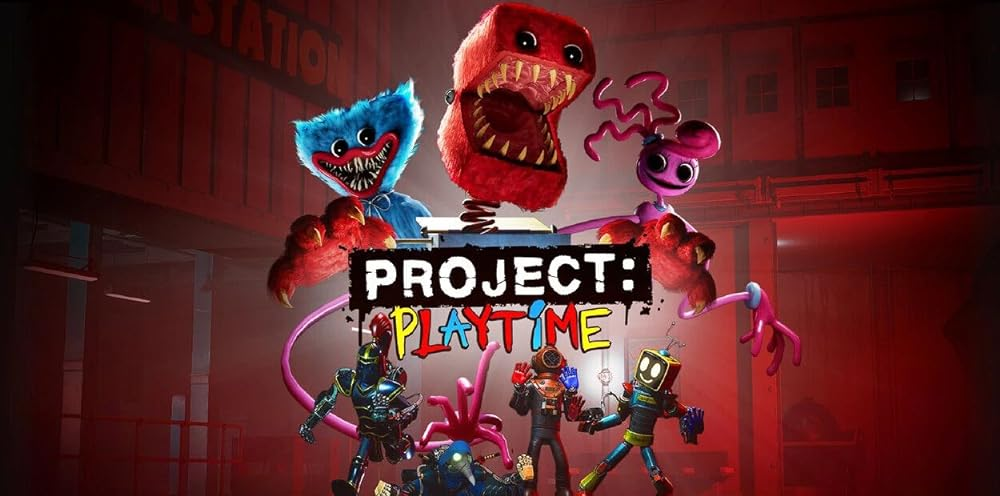
If I could be diplomatic for a second… what the fuck is Project: Playtime?
I mean that in two ways; first of all… what actually is it? Seems like an online multiplayer Dead By Daylight style survival co-op game; the exact kind of thing that I have basically zero interest in. Not to say that it’s artistically without merit, I just tend not to find multiplayer horror experiences very scary, because any tension is quickly dispelled due to presumably being on a voice chat with the friends I’m playing with, probably saying “Whoa! Slow down, Maurice!” every time a monster shows up. It’s not for me, but if other people enjoy it, good for them, and good for Mob for making it.
The second way I mean it, however, is closer to… Mob Entertainment, what the actual fuck are you thinking, you colossal morons? I- this is an episodic series of games, and after releasing just two of presumably a minimum of five episodes, you decided to branch out into an online multiplayer game? Wh- do you think you’re ready for that? Do you think that maybe you should at least get halfway through your current project before embarking on an entirely separate spin-off? FNaF World didn’t come out until there were four established games in the series. You are approximately 40% through your first game. You don’t think that maybe you should spend a little more time creating and releasing actual products on your journey to create a horror franchise empire? When Five Nights at Freddy’s expresses more restraint than you, you know you’ve done fucked up. At least Project: Playtime is also in early access, so even the spin-off they made while their main game was unfinished, is also unfinished. Great. And I don’t even want to dignify the Poppy Playtime Roblox game released earlier this year with an acknowledgement, outside of this sentence.
Also, to go back to lore being hidden in sources outside of the game, of course most of the explicit story – evil doctor trying to transplant human (specifically children for some reason, for maximum evil, I guess?) souls into robot bodies in order to cut the costs of human workers – is found in the spin-off. Also, we desperately need to take a second to acknowledge that the overall villain of Poppy Playtime is a morally bankrupt businessman trying to squeeze maximum money out of his venture, with no regard to ethics or the human cost… and did I mention that Mob Entertainment also dabbled in NFTs? Pay 350 Dogecoins now to get your very own Huggy Wuggy NFT and uncover the exclusive lore of what his favourite colour is! (It’s blue.) I just- I feel like this is personally unfair to me as someone writing about this, because the joke of ‘evil human villain does unethical things for money’ being written by a company who sold NFTs (they stopped after a predictable backlash) and presumably began working on a spin-off game before they had even released Chapter Two, is such an obvious set-up that I don’t think any punchline I could reach would be as effective as simply stating those facts in order.
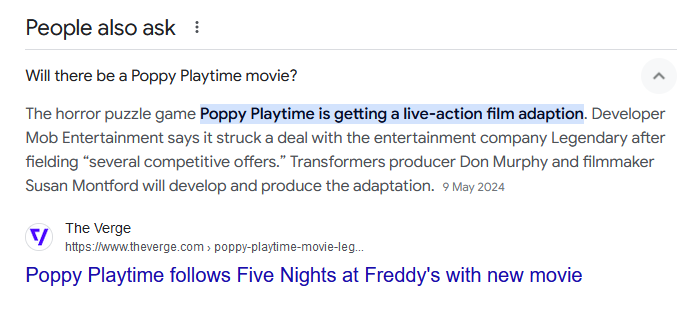
Mob Entertainment also announced earlier this year that they would be branching out into the world of film – still way ahead of themselves, but at least Chapter Three came out with some decent story bits – to try and steal some more of that FNaF popularity.
… Oh, hang on, Deadline Hollywood reported that they were seeking to make a film adaptation back in April 2022. Which was still a full month before Chapter Two released. Chapter Two. Out of five. April 2022.
I’m just going to say it; I’m getting ‘Juicero’ vibes here. Please look up the story of the Juicero if you’re not familiar, it is a wonderful journey that you will not regret… unlike anyone who ever invested in or purchased a Juicero.
Not to belabour the comparison, but the Five Nights at Freddy’s film was released nine years after the first game was released, and more importantly, after there were already nine core games in the main series, with Help Wanted 2 coming out at the tail end of 2023 to wrap it up to a nice round ten. Hell, it wasn’t even really the first FNaF-inspired film to come out; The Banana Splits Movie in 2019 was a dark, clearly FNaF-inspired take on the characters, and in 2021 there was that weird-ass Nicolas Cage film (oh yeah, like that description narrows it down,) Willy’s Wonderland in which he plays a night guard – no wait, janitor – at a Chuck E. Cheese style establishment who spends the night fighting off a bunch of killer animatronics. If anything, a Five Nights film adaptation could have arguably come out sooner.
Meanwhile, Poppy Playtime were out here shopping for investors when they all they had was a goddamned demo. Ask yourself this; given what we know about the shareholders of Poppy Playtime and their general attitude towards business (cough cough NFTs) then were they looking to make a film because they had a creative vision in mind that they felt was worthy of being projected onto the big screen? Or, are they venture capitalists who only love three things – cocaine, money, and more cocaine – and they have zero understanding of the effort necessary to actually create a beloved media franchise and they’re just trying to brute-force Poppy Playtime into becoming ‘the next big thing’ by any means necessary?
It reminds me of the downfall of Guitar Hero, once one of my favourite video game franchises – well, it was in the Top 10 at least – which was destroyed by churning out so many spin-offs and cheap cash-grabs in such a short amount of time that it collectively destroyed their audience’s interest in the series and crashed their sales. And Guitar Hero was an established series that people liked. Poppy Playtime is currently 60% of a game, and they were pitching a film back when that number was just 20%. A more accurate comparison would once again be Hello Neighbor, a mediocre game with a ridiculous amount of spin-offs; presumably in the hope that at least one of them would be successful. You cannot brute-force your way into a quality product.
Poppy Playtime may have walked back on their venture into NFTs, but the people who made the decision to try that shit in the first place are still there. And their approach to business is still pushing Poppy Playtime to branch out into films, toys, board games, themed sanitary pads and more, desperate to get their brand out there. The fact that their entire ‘brand’ at this point is no more than two unfinished video games is merely a minor setback in their goal to make obscene amounts of money. After all, video game companies who chase trends and answer to a board of shareholders with no experience or interest in the industry always succeed, 100% of the time. Hmm. No, wait, it was either ‘succeed’ or ‘fail’. Ah well, one of the two, and I can’t be bothered to check. Full steam ahead, Mob Entertainment! Also, please remember to clean your Juicero.
The, uh… ‘gameplay’

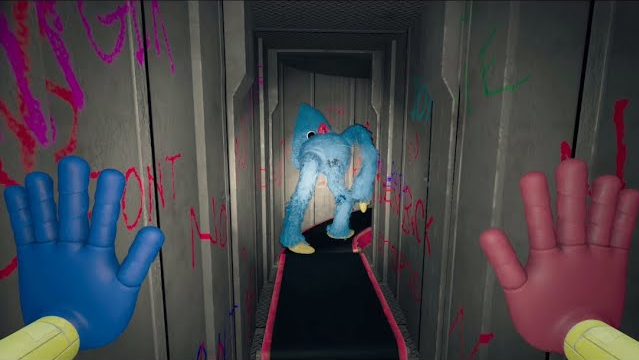
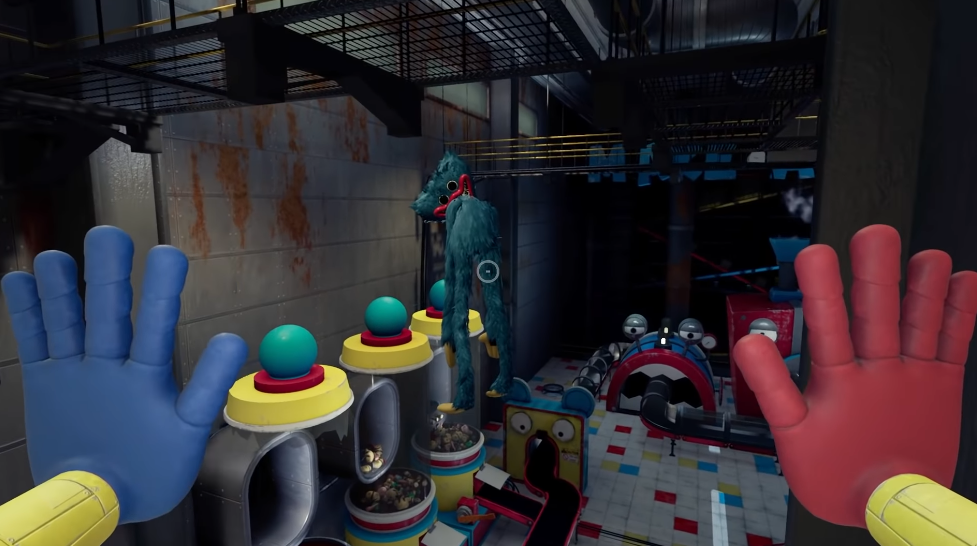
More like Buggy Wuggy, ha ha ha – no-one’s made that joke before, I bet.
I think it says a lot about the artistic merits of Poppy Playtime that “… Oh yeah! The gameplay looks kind of rubbish,” is only the fifth most pressing concern I have about the future of the series. Arguably the very first thing I would be covering in a discussion of a game that I was optimistic about. Or, to be blunt, cared about actually playing myself.
But a lot of Poppy Playtime fans honestly don’t go out of their way to play the game – the 60% of it currently available, at least – themselves. That’s a blessing and a flaw when it comes to viral horror games; plenty of people who don’t play the games will at least keep up with it by watching their favourite Let’s Play-ers, streamers and vtubers run in fear from Huggy Long Legs or Mommy Missy or whatever, but they might not actually financially contribute to the success of the game in any way. And that’s fantastic in terms of exposure, advertising and facilitating clickbait videos and articles, but… those people still aren’t paying you.
And why would they? Poppy Playtime isn’t a platformer that’s inherently fun to play on its own merits, the puzzles don’t give a significant amount of satisfaction upon completion; the primary attractions of games in the vein of Poppy Playtime are the horror and the lore, both of which can very easily be experienced by just watching an internet personality play them. There are a lot of horror games that have piqued my interest enough that I want to know more about them, without actually having to play them – a very backhanded compliment, but still a compliment nonetheless, kind of – and I bring this up because while there is no shortage of horror games I am curious about but don’t want to play (I’m more of an Eternal Darkness/Haunting Ground guy than a FNaF guy) then I don’t think I have ever decided more quickly that I didn’t want to bother playing the game than Poppy Playtime.
… Alright, well in all fairness, that’s not true; I really did not care for the look of Baldi’s Basics. But that one never piqued my interest to begin with, so I don’t think it even counts.
Poppy Playtime though… I have just never gotten the feeling that I have ever been missing out on anything by just watching a Let’s Play rather than actually playing the games. And that’s decidedly not a compliment. And that’s mostly because the gameplay just looks bad. For one thing, it’s missing my favourite horror trope, present in almost all of my favourite horror games; chase scenes are one thing, but to really build tension, you need a stalker. Haunting Ground, Clock Tower, Outlast, Resident Evil 2 and 7; all of these have moments where you aren’t being chased, but a pursuer is actively exploring the grounds looking for you, and you have to go to great lengths to avoid them. And they’re all fantastic for this reason. It’s so much more effective than the old ‘jump-scare into chase’ sequence, which… now that I think about it, actually describes the first Clock Tower game as well, but your goal there is not to escape, but simply to hide, hold in your breath, and hope that your pursuer goes away. It’s tense in a way that Poppy Playtime cannot replicate.
In addition to this though, Poppy Playtime just features a combination of puzzles that look extremely uninteresting to me, and also a general jank and bugginess that make the gameplay perfectly unappealing to me. This is because the gameplay seems to be split into two categories; basic physics puzzles, the kind that Hello Neighbor also employs – and it is never good to be compared to Hello Neighbor in any regard – and… wacky arm-shenanigans.
One of the first things you will do in Chapter One is find a GrabPack™, two plastic hands capable of grabbing things from far away. I’m tempted to snark “So I guess we can add the hookshot from Legend of Zelda to the list of things Poppy Playtime is ripping off,” but it’s functionally different enough, and it’s utilized in far more puzzles and in far more creative ways over the course of each chapter. Aside from just grabbing items and pulling boxes out of the way, your GrabPack™ hands can also conduct electricity, somehow, which means that there are some puzzles where you grapple onto something and then run around tying your big Mr Fantastic/Stretch Armstrong arms around a bunch of conduits and then completing the circuit, which somehow keeps running even when you retract your GrabPack™ arms. It’s all… fine, but they don’t seem like satisfying puzzles to solve, and the multitude of glitches upon the release of every single chapter has seen an alarming number of puzzles solved by accident in ways that shouldn’t have worked. Albeit sometimes, the intended solution wasn’t working either, so I can’t exactly fault the players.
The GrabPack™ in Chapter Two received an upgrade – well, a replacement hand – which can store electricity, which means running back and forth from a power source, charging up various panels which allow doors to open, and a lot of the time, immediately taking back the electricity that you just provided, so that you can provide it to another panel, which you might then steal it back from, because there’s a time limit, and… look, I am making no secret of the fact that I have not played the game, so if you really enjoy this gameplay, then good for you, my disinterest in no way invalidates your interest, and I’m happy for you. But I also can’t deny that I’ve watched every moment of every chapter so far, and I have never, ever thought to myself “… That looks fun!”
I think Mob Entertainment may have realised this, because in Chapter Three, the two GrabPack™ upgrades you get – you can just swap them out now, thanks to switching to the GrabPack™ 2.0™ – are a flare gun, used to scare away little critters, and a purple hand that interacts with bounce-pads by launching you into the air. I don’t know why it only works on bounce-pads, and not… the ground in general, but alright. These are fine, but neither of these are used for anything I would describe as a ‘puzzle’. I know that the chase scenes are the frequent highlights in Poppy Playtime, but it’s a little disappointing that any time that the player is not being chased, the gameplay comes across as filler at best, and tediously dull at worst.
™
Conclusion: I Am Worried
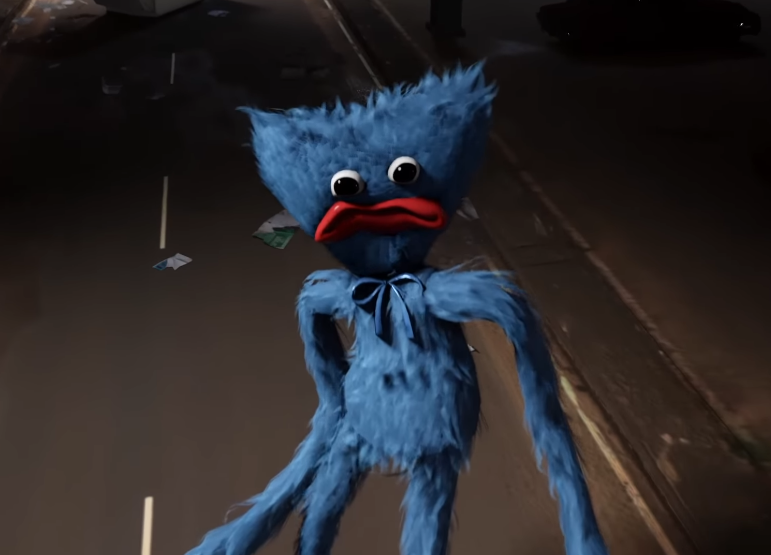
Given that my allegedly mixed feelings have been a lot more negative than positive, it would be a relief for me to just say that I don’t like the game, and therefore if it turns out to be a huge disappointment, if Poppy Playtime ends up a victim of horrific mismanagement, and becomes a cautionary tale of a developer trying to do too much too quickly, then I can sit back on my throne of schadenfreude and think “Ha ha, told you so.” But I just can’t, because… there are things about it that I just really like. I want it to succeed. I want all of my worries to amount to nothing, and even if the game never turns into something that I personally would want to play, I want to look back at this article in five years and think “Wow, I was so wrong!” But I don’t think that I will, and not just because I’m incredibly stubborn.
What hurts me the most about Poppy Playtime is that there is so much talent behind… parts of it. The design, the art, all of the story stuff on Mob’s YouTube and Twitter. There’s a lot of creativity and a surprising amount of originality for a project that appears to be trying to break the record of sources from which they have ‘taken inspiration from’. I haven’t even mentioned the voice-acting; Avalon Delaney – the lead 2D artist with no previous voice-acting credits (except for a YouTube-exclusive Minecraft cartoon) – as Miss Delight in Chapter Three alone puts on a more impressive performance than the combined casts of some other horror games I’ve played. There is so much talent contained within Mob Entertainment, and… I can’t help but feel that their efforts will probably not result in the success that the studio – and especially the shareholders they’ve gotten to invest in their fucking film – will consider satisfactory. I had no idea until I looked it up just now that the voice actress behind one of the game’s best performances so far, was also one of their lead artists. That… could be nice? Like, maybe they just thought it would be cool to have an artist – one who is clearly talented at voice-acting – voice one of the characters in the game! Or… maybe with all of the effort going into their multiplayer endeavours and plushie promotions, and that fucking film that they absolutely should not be even considering making for another three to four years, minimum, then it was easier to get one of their artists to double-up roles rather than finding someone else. I at least hope that she got paid well.
And that’s basically the gist of it; I have full, unwavering faith that the people behind Poppy Playtime are more than capable of delivering on the expectations of fans worldwide – which possibly includes me – and producing a fantastic horror experience. And I have zero faith that the management – who thought that hiding game-lore behind NFTs – are capable of the same. And I know which of those two groups is calling the shots in the company.
Poppy Playtime is a currently unfinished game that shows plenty of promise, which I sincerely hope is released in full one day and is entirely good. But I cannot honestly say that that’s what I’m expecting to happen. And until they prove me wrong, I will continue to have very mixed feelings on Poppy Playtime.
Thanks for reading!
-Dopefish


Personally, I find REDACTED of REDACTED to be more compelling than most mascot horrors, including FNAF, at least with their most recent installment. It really feels like it went on a journey.
And as far as gaming ripoffs go, there is no beating Limbo of the Lost. A commercial release that stole most of its art assets from popular contemporary games.
LikeLike
I Like ur articles a lot. Good job. i Dont have money so no patreon support. But i hope u post more. Bye bye
LikeLike